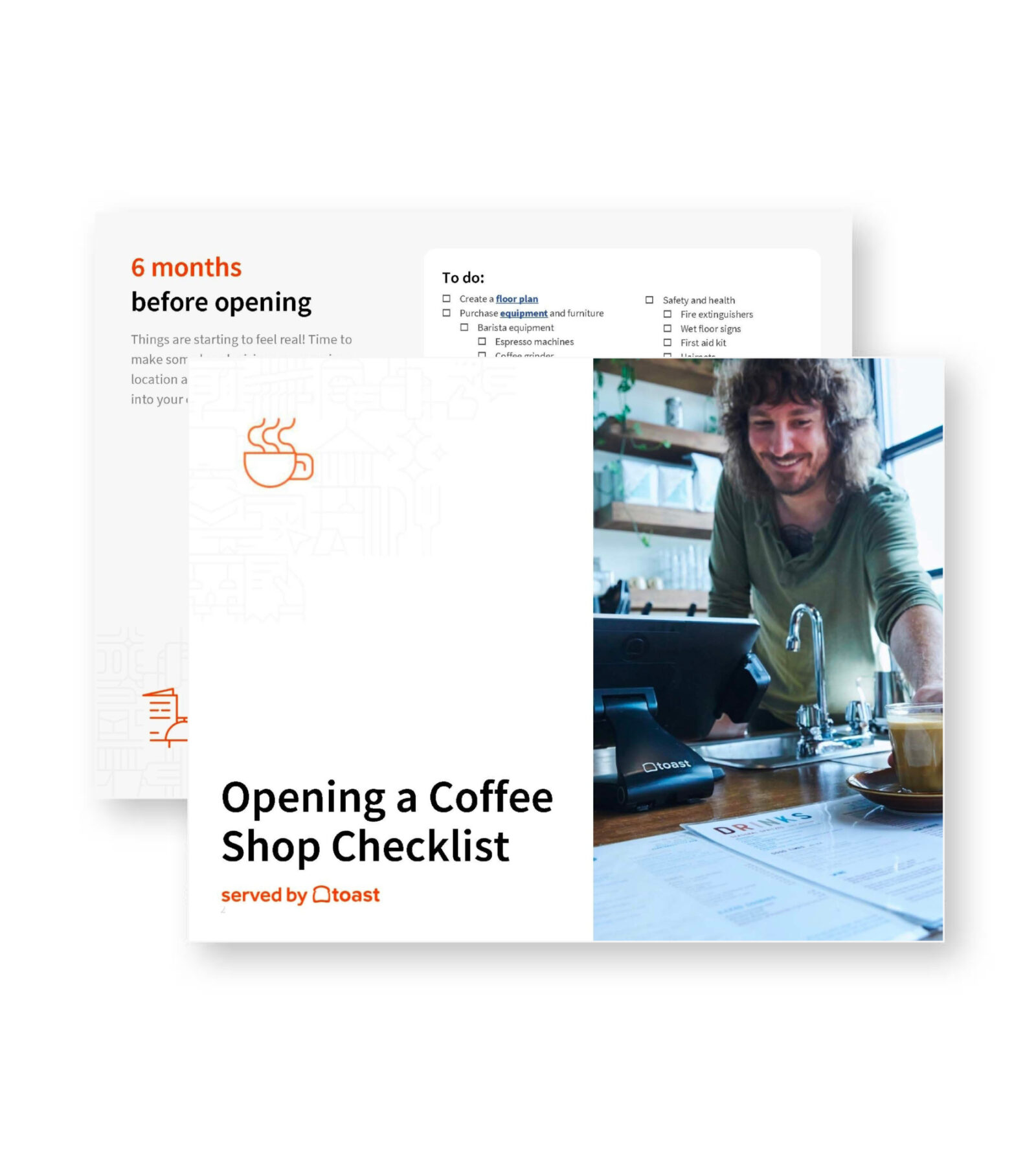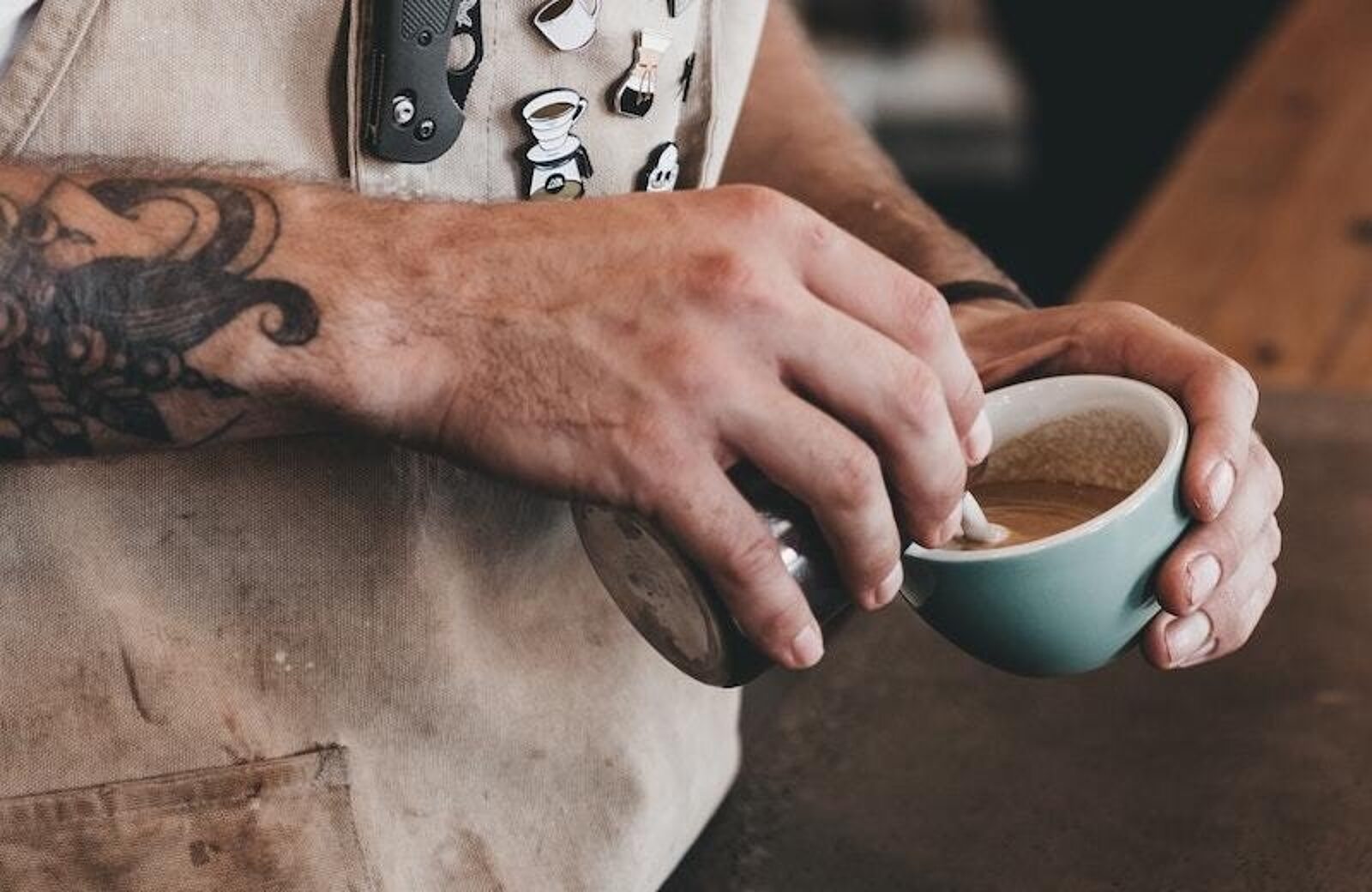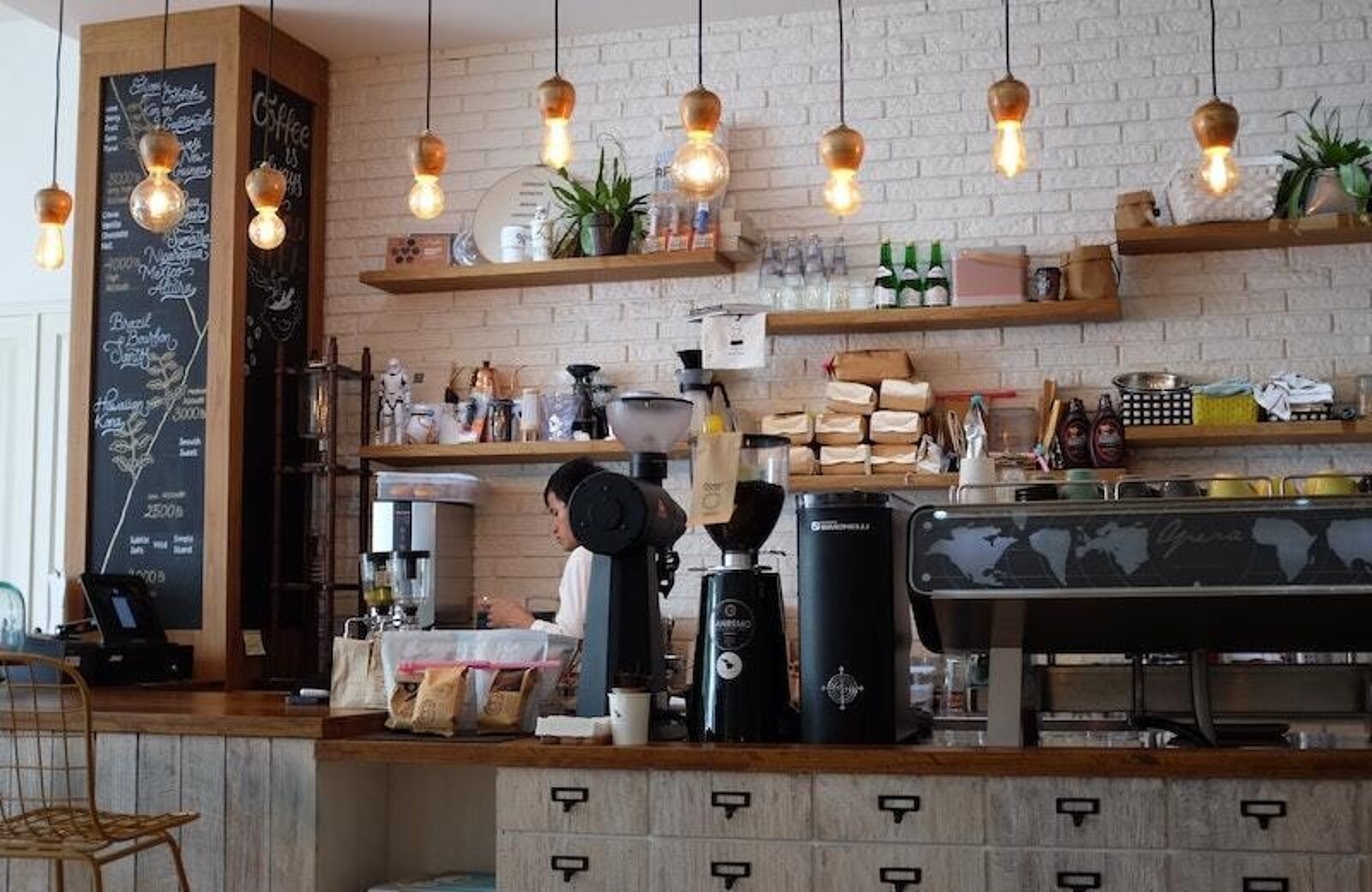
A Guide to Different Types of Tea and Coffee
Contemporary coffee and tea culture is a lot to navigate – get advice about buying and brewing from an industry professional.
Tyler MartinezAuthor


Opening a Coffee Shop Checklist
So many things go into opening a coffee shop. With this free PDF checklist, you'll set your new business up for success.
Get free downloadDrinking coffee and tea is a practice that has roots that go back thousands of years. And associated traditions have been refined over centuries, to become increasingly nuanced and complex.
Restaurants and cafes have been able to offer higher and higher qualities of coffee and tea, as improvements in harvesting, distribution, research, and brewing have had reverberating effects on the industry.
There’s a lot of information available about coffee and tea too, and it can be hard to determine what’s relevant to you. This guide is designed to help you navigate the coffee and tea industry, and make decisions about how to incorporate types and trends into your establishment.
Types of coffee
Building a coffee menu can seem daunting, considering the competing information on the internet. I cover the basics of coffee in depth in A Guide to Different Types of Coffee Drinks.
Deciding what type of coffee you want to offer is a great first step. Do you want to provide just drip coffee, or would you like to sell espresso beverages too? How important is quality to you (or your customers)? What coffees might compliment the rest of your menu?
Arabica coffee
Some roasters are challenging assumptions about the differences between Coffea robusta and Coffea arabica, although of the two, arabica is the species that’s generally more highly prized.
Arabica coffee is shade-grown in high altitudes. And as with wine grapes, the growing region influences the flavor profiles of both the roasted coffee bean and the brewed coffee. Arabica coffees are said to have deeper, more complex flavor profiles and less caffeine than Robusta coffees.
Robusta coffee
Robusta coffees can be grown in harsher conditions and at lower altitudes than arabica coffees. Generally, robusta coffee plants are more tenacious and resilient than arabica plants. They produce higher yields at the cost of some complexity of flavor.
Single-origin Coffee
Specialty coffee shops usually roast and sell two types of coffee – single-origins and blends. Single-origin implies that the coffee beans hail from one origin, country, or even farm.
Roasters usually proudly disclose where their single-origin coffees are from, and sometimes have close relationships with the coffee farmers. Single-origin coffee is a must for specialty cafes, while bakeries and restaurants often prefer to serve a less expensive blend.
Because single-origin coffees come from one place, the same coffees aren’t available year-round, and shops rotate their offerings along with what is available each season. Coffee harvests are sometimes inconsistent, and roasters and baristas have to adjust their approach to the changing product.
As a restaurant or café manager, the primary benefit of partnering with small roasteries that work with single-origin coffees is that the roaster can usually build a custom flavor profile for the coffee, to best complement your food offerings.
Selling single-origin pour-overs or drip coffee is a great way to let your customers know you’re serious about providing a next-level coffee experience. Imagine you run a bagel shop. Providing high-quality, freshly roasted coffee to your customers allows them to get their morning meal and beverage all in one place.
Coffee blends
Any coffee that is composed of two or more origins of beans is considered a blend. Coffee blends are excellent at highlighting the desirable flavor notes in certain beans. A nutty batch of beans from Colombia or Guatemala might be too bitter when brewed as a single-origin, but their flavors are complementary when roasted together.
Blends have consistent flavor profiles, because roasters can make adjustments to create the precise product they’re looking for. Restaurants often serve blends from specialty roasteries, so that they can rest assured that they’re serving their customers predictably good coffee.
Most mass-market coffees (think Folgers), are also blends, primarily containing beans from South and Central American countries. Large companies that stick to a consistent blend and roast profile don’t often disclose exactly what’s in their blends, because it’s likely to change with what beans are in season.
Blends tend to be roasted a little darker than single-origins, which also contributes to a more consistent flavor profile. The basic lesson of blends vs. single-origin is that blends can be consistent and delicious, but that more depth of flavor is available from single-origins.
Light roast coffee
Light roast coffee is roasted just past the first crack. That’s a technical way of saying that it’s roasted for less time, allowing fewer Milliard reactions to happen and resulting in a lighter-colored coffee.
Light roasts are popular among small-batch specialty roasters, because it gives them more control over how the flavors in a coffee develop. Ethiopian and other African coffees, along with some South Asian, Hawaiian, and Central American coffees, are often light roasts.
Sweet, fruity, floral, and syrupy flavor notes are characteristic of light roast coffees. They can also be citrusy, acidic, and vegetal. I’ve tasted light roasts that reminded me of blueberry juice, and others that tasted like tomato soup.
Medium Roast Coffee
Medium roast coffee is roasted further into the first crack stage – so a few more minutes than a light roast, but not yet approaching the second crack. This allows Milliard reactions to make the coffee a little darker and toastier.
Specialty coffee shops are likely to brew medium roasts for their default drip, and a lot of the grinds people take home are medium roast blends. Medium roasts are also popular in espresso machines in specialty shops. Coffees from all regions are used for medium roasts.
Medium roast coffees are often nutty, chocolaty, and sweet with some undertones of floral and stone fruit notes. My favorite medium roast single-origins are Peruvian and Guatemalan coffees, that brew caramelly cups with notes of apple, plum, and grape.
Dark Roast Coffee
Dark roast coffees are roasted almost to second crack or into second crack, to develop dark, rich colors and flavor profiles. The consistency of mass-market coffees and national coffee chains is achievable because of darker roasts. Traditional espresso roasts are also dark roasts.
Dark roasts coffees offer nutty, rich, chocolatey, and dark berry flavors. The best dark roasts I’ve had (which are also usually on the lighter end of the dark roast level) brew a cup that tastes like sweetened milk chocolate.
Decaf Coffee
There are two primary ways of decaffeinating green coffee beans – solvent-based and non-solvent-based. The solvent-based decaffeination process uses a chemical to dissolve the caffeine in coffee. Non solvent-based processes use either water or carbon dioxide.
Water processed decaf coffees are preferred by most specialty roasters because the process is more transparent. And it doesn’t alter the flavor profile of the resulting roast as drastically as solvent-based processes. A lot of the decaf coffee in the US is grown and decaffeinated in Mexico.
Most customers expect decaf coffee to be an option in cafes or restaurants. You don’t necessarily need to offer as many varieties, but you should have at least one decaf on hand.
Espresso
Espresso coffee is brewed under pressure. Coffee of any origin or roast level can be brewed as espresso, even if traditional espresso roasts are dark roasts. Espresso is combined with steamed or cold milk in various volumes to make different beverages. [TM4] . If you plan to serve coffee in your restaurant, bar, or café, you’ll have to decide if you want to offer espresso drinks as well.
Coffee Packaging and Shelf Life
Another important factor to consider is the packaging and shelf life of coffee beans and grounds. Coffee needs a couple of days to oxidize to develop an optimal flavor profile. And while it’s possible it got a chance to oxidize in the roastery, it’s a good idea to open a fresh batch of coffee prior to brewing.
Coffee beans release oils after they’re roasted, and will become shiny with oil after a couple of weeks. Coffee beans are only good for three to four weeks after their roast date unless they are in sealed packaging, which extends the shelf life by a couple of months.
It’s important to store coffee where it won’t be exposed to excess light, air, and heat, and it’s especially important to avoid storing coffee in humid environments. Dark, cool, dry, and airtight containers are ideal for storing coffee beans that you’re not getting ready to brew.
If you’re working with a specialty roaster, I’d suggest asking them about the aging and shelf life of their products. They might even offer to help train your staff on how to brew and sell their coffees!
Types of Tea
The leaves of the Camellia sinensis plant are picked, dried, processed, and brewed to make tea. Establishments usually offer a selection of green, black, and herbal teas.
Once the tea leaves are processed, they’re exposed to air and begin to oxidize. Some teas are exposed to oxidation long enough for fermentation to begin. Fermentation is a natural, exothermic reaction involving enzymatic oxygen and the polyphenolic compounds in the cell sap.
White Tea
White tea is made from the young shoots of the plant, which are processed only minimally to maintain a naturally sweet, subtle flavor. White teas are low in caffeine, but some say that harvesting the leaves while they’re young preserves more of the plant’s natural antioxidants.
White teas should be brewed with warm (not boiling or scalding) water, so that the tea isn’t burned during brewing and the best flavor possible can be extracted.
Types of Green Tea
Green teas are made from the mature leaves and shots of the tea plant, and are processed – oxidized or fermented – for longer than white teas. Green teas should also not be brewed with boiling water, which makes the drink over-extracted and bitter.
There are lots of varieties of green tea, including teas flavored with dried fruits, berries, or flowers.
Oolong Tea
Oolong tea is a type of green tea that is semi-oxidized, meaning that it falls into a range between green and black teas. Many oolong teas are made with the highest quality plants and taste rich, buttery, and earthy.
Matcha Tea
Matcha consists of high-quality green tea leaves that are dried and ground into a fine powder. It’s then whisked with hot water to make a flavorfully grassy cup of tea. Matcha powders are used to make blended and iced drinks and lattes, and are baked into all sorts of tasty treats. It’s a versatile ingredient for bartenders, baristas, and bakers.
Types of Black Tea
Black teas are fully oxidized, which is responsible for the dark color of the drink. Black teas are sometimes allowed to ferment and develop more complex and nuanced flavors.
Like green teas, black teas are often blended with dried fruit and flowers, and brewed with various spices and herbs. Earl Grey, one of the most notable types of black teas, is made with the oil of bergamot oranges.
Chai Tea and Chai Lattes
Chai is the Hindi word for tea. In the U.S., chai refers to black teas that are mixed with a blend of spices; usually ginger, turmeric, cinnamon, nutmeg, and clove. Chai lattes are especially popular: adding steamed milk and vanilla syrup to chai yields a pleasingly spicy and creamy drink.
Types of Herbal Tea
Herbal tea isn’t tea. That is, herbal tea doesn’t use the leaves or shoots of the tea plant, but is made by brewing various herbs, flowers, dried fruits, and spices. Herbal teas are usually caffeine-free with the notable exception of Yerba Mate, which is a caffeine-rich herb that makes an earthy tea. Hibiscus tea, one of the most common herbal teas, has a bright pink color and is high in antioxidants.
Tea Storage and Shelf Life
Teas are dried, which is a process that ensures a long shelf life. Teas are usually good to brew for six months to a couple of years, depending on the kind.
The oils in teas can go rancid, especially after prolonged exposure to oxygen. Store teas in air-tight and non-porous containers that will keep the aroma of the tea in and ambient aromas out.
Tea Drinks
Whether hot or iced, creative baristas and bartenders use teas in unique drink concoctions and combinations. Teas are often flavored with spices, dried fruit or berries, and herbs. Some common flavors include jasmine, elderberry, lemongrass, mint, orange, lemon, raspberry, blueberry, cinnamon, ginger, turmeric, chamomile, and vanilla.
Boba Tea and Milk Tea
A popular trend in tea drinks is boba teas and milk teas. Tapioca pearls or flavored popping bubbles are added to iced teas with sugar and milk. A wide straw is served with these drinks so that you can slurp the pearls and tea at the same time.
Setting up for Coffee and Tea Service
Here’s some general advice to help you to set up coffee or tea service in your café or restaurant.
Coffee and Tea Cups
Durable ceramic mugs for coffee and teas are preferable for dine-in service. They’ll last longer and insulate your beverages more efficiently.
There are some great, sustainable options for single-use take-out coffee cups. Specialty coffee shops are moving to cold cups that have sip lids, and eliminate the need for straws. Hot cups that have insulation built-in help bypass the cup-and-sleeve system, which also reduces waste.
Coffee and Tea Extras
Syrup, flavors, garnishes, milks, boba, popping bubbles, whipped creams, cold foam, sparkling water, gelato – the list goes on. Equipping your establishment with a wide range of mix-ins will allow you to craft creative, unique drinks for your customers.
Brewing Coffee and Tea
Do your research. There’s a lot of great information out there about how to brew coffee, pull espresso shots, and make tea — too much information for the scope of this article!
Building a Coffee and Tea Menu
What coffees, teas, and beverages are right for your café or restaurant? How will you structure your drinks program to compliment your food? Consider working with a local specialty roaster that can help design a flavor profile to pair with your menu.
Related Coffee Shop Resources
Menu Engineering Course
Take this course to make the most of your menu. Learn about menu psychology and design, managing your menu online, and adapting your menu to increase sales.

Is this article helpful?
DISCLAIMER: This information is provided for general informational purposes only, and publication does not constitute an endorsement. Toast does not warrant the accuracy or completeness of any information, text, graphics, links, or other items contained within this content. Toast does not guarantee you will achieve any specific results if you follow any advice herein. It may be advisable for you to consult with a professional such as a lawyer, accountant, or business advisor for advice specific to your situation.
Read More
Subscribe to On the Line
Sign up to get industry intel, advice, tools, and honest takes from real people tackling their restaurants’ greatest challenges.



